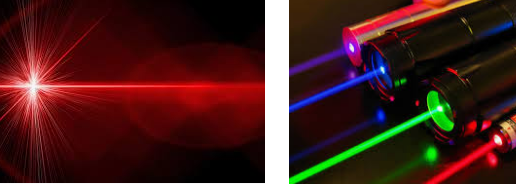What are Lasers?
1) Lasers stands for light Amplification by Stimulated Emission of Radiation.2) The working of lasers is based on stimulated emission of radiation and population inversion.
3) The main components of a laser are:
a) Active medium (A)
b) Pump (P)
c) Resonator guide
 |
| Lasers |
The active medium may be an atomic or molecular gas e.g. CO2, He, Ne, a liquid die solution or solid rod of ruby. The pump is a device for achieving the population inversion. The population inversion is a phenomenon of shifting atoms ordinarily in ground state to the higher energy state. The process by which population inversion is carried out is called optical pumping. In laser, pumping can be achieved either by optical means using a flash lamp in a ruby laser or by electrical discharge which is particularly suited for gaseous active medium or by using suitable exothermic chemical reaction.
The resonator guide is that component of laser which guides the process of stimulated emission induced by spontaneous emitted photons in the active medium, resulting laser beam of unique properties. In a simplest form of laser system, the optical resonator guide is a pair of plane mirrors M1 and M2 set on an optic axis and held parallel to each other, where M1 is perfectly reflecting and M2 is partially reflecting mirror. The active medium is placed in-between these mirrors. This arrangement selects only those of the emitted photons which move along its axis whereas the other photons are rejected. As a result of which, a laser beam of high energy is obtained.
4) There are four type of laser in use
a) Gas lasers
b) Solid lasers
c) Liquid lasers
d) Semiconductor lasers
Gas lasers
These lasers use a mixture of helium and neon enclosed in a glass tube as an active medium, at a pressure of about 1 torr of helium and 0.1 torr of neon. The two electrodes sealed in the tube are connected to the source of light voltage d.c. in order to get the discharge in the tube which is acting as a pump. The two plane mirrors M1 and M2 fitted parallel to each other near ends inside the tube act as resonating guide. Mirror M1 is perfectly reflecting and mirror M2 is partially reflecting. |
Gas lasers
|
Solid lasers
These lasers use a cylindrical crystal A as ruby for the active material surrounding the crystal acts as a pumping arrangement. The ends M1 and M2 of the ruby crystal are polished, optically flat and parallel end M1 is perfectly reflecting for light and end M2 is partially reflecting for light. When a pulse current of high voltage is passed from a source of current, the ruby is excited. Due to which a red laser beam of high intensity flashes out. |
Solid lasers
|
Liquid lasers
These lasers use organic dyes which are enclosed in a glass tube for an active medium. The dye is circulated into the tube with a pump; A powerful pulse of light excites the organic dye. |
Liquid lasers
|